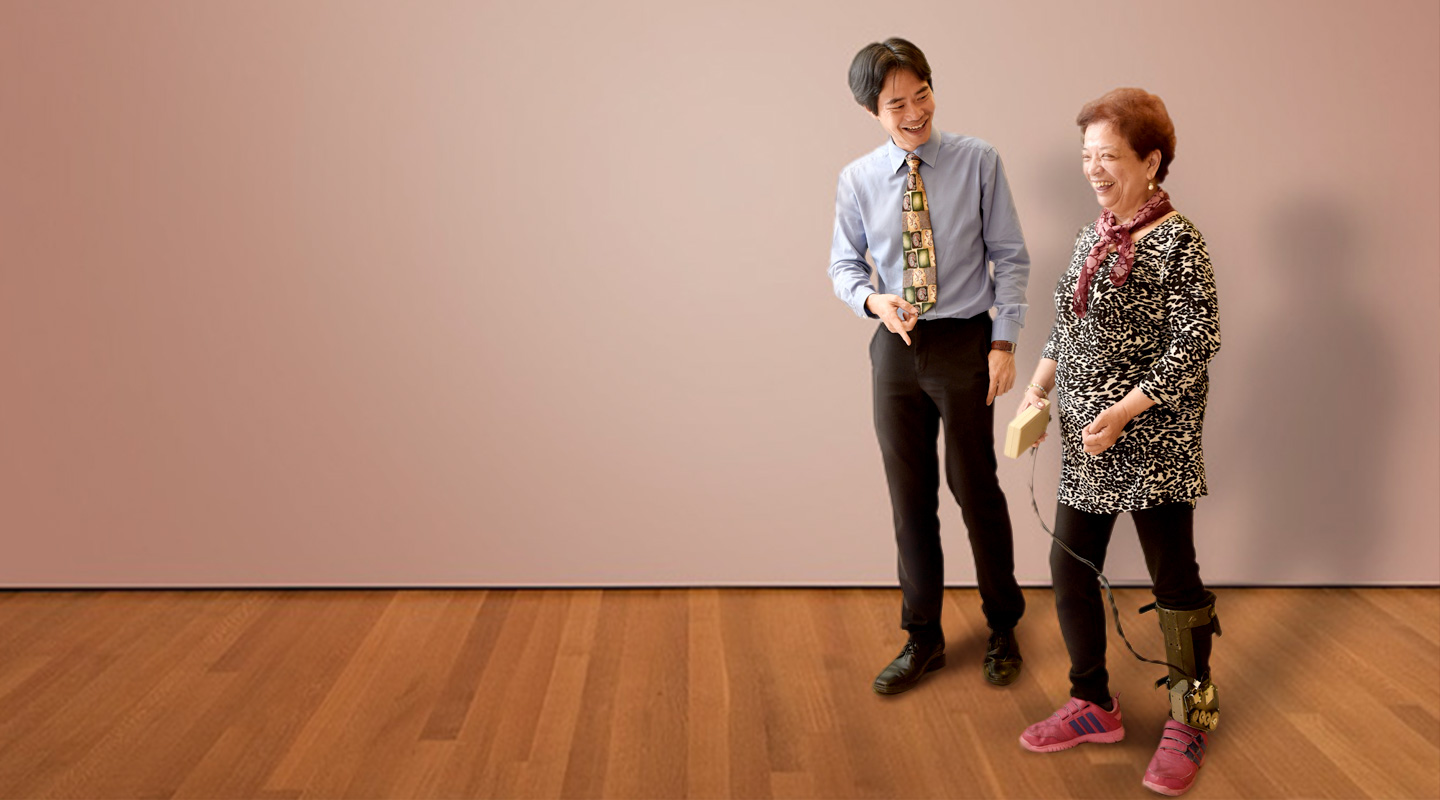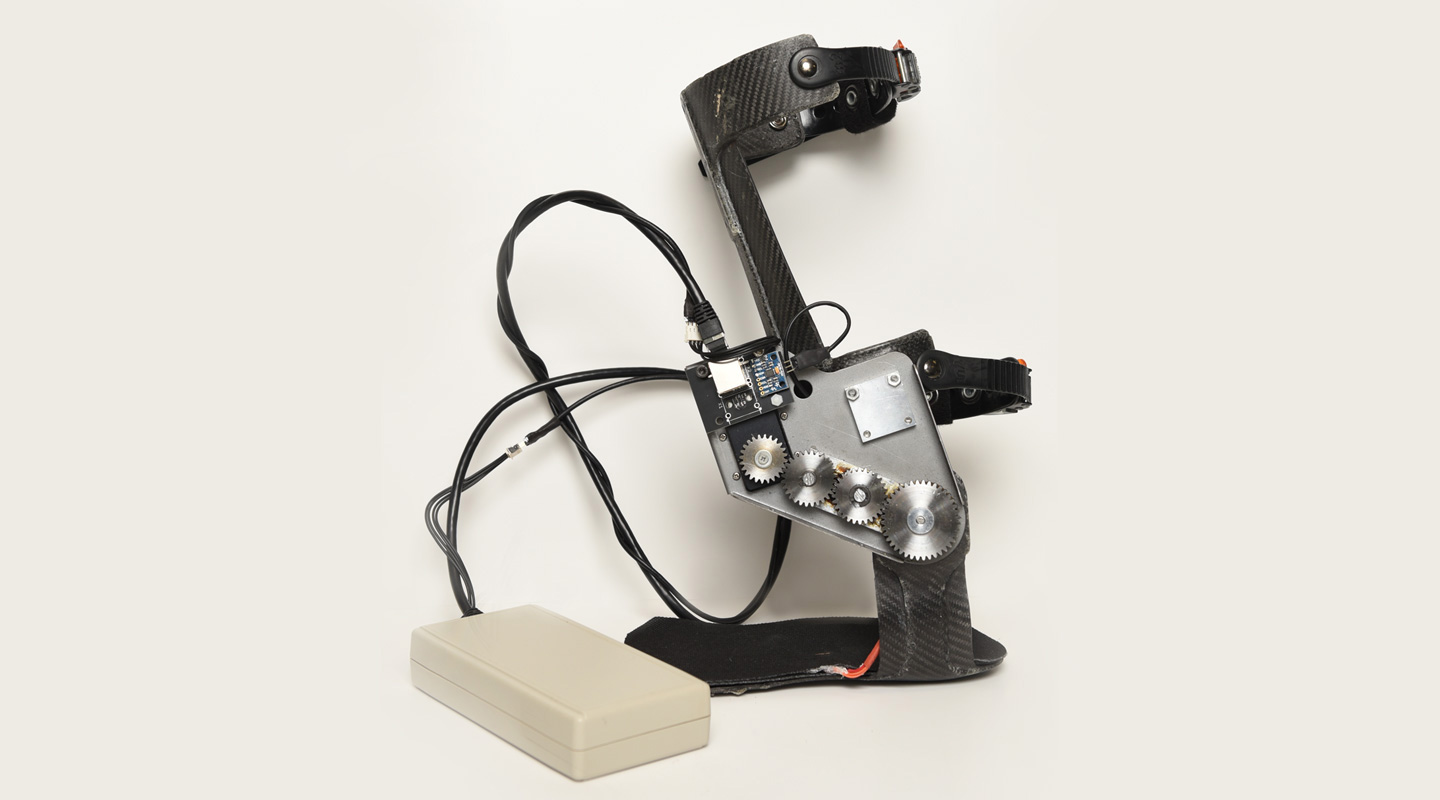Dear readers, With the launch of e-newsletter CUHK in Focus, CUHKUPDates has retired and this site will no longer be updated. To stay abreast of the University’s latest news, please go to https://focus.cuhk.edu.hk. Thank you.
Small Gadget, Big Steps

Stroke is a major cause of disabilities worldwide. One of its devastating consequences is hemiparesis, paralysis of one side of the body. The loss of patients’ motor functions causes foot drop, the neuromuscular disorder which induces inability to lift the forefoot, and results in dragging their toes along the ground and increased risks of falling and ankle spraining.
Prof. Tong Kai-yu Raymond (left, top photo) of the Biomedical Engineering programme, Department of Electronic Engineering, CUHK, collaborated with Dr. Wai Hon-wah of the Industrial Centre at The Hong Kong Polytechnic University to design an Interactive Exoskeleton Ankle Robot, which helps those stroke survivors with foot drop to walk more safely in both indoor and outdoor environments.
Active Sensor System with Algorithm
The robotic ankle provides power assistance to the ankle joint movement with proper feedback to improve the users’ gait pattern. The system is light and portable. Its carbon fibre structure is flexible enough to be adjusted to different leg lengths.
Professor Tong said, ‘With the ankle robot fitted on the user’s shank, the embedded motion and force sensors will sense the user’s gait pattern. The system’s algorithm can classify the user’s gait intention based on the kinetic and kinematic gait parameters to predict his/her motion, which enables the robot to actuate the ankle joint with its powered assistance.’

Gait Restoration in the Aftermath
Ms. Tsui (right, top photo) is a 65-year old stroke survivor. She had an acute ischemic stroke in October 2009, a few days after her birthday and participation in a dance competition. She had been hospitalized for eight months due to problems such as hemiparesis and dysphagia, and she once broke her arm accidentally because of her gait and balance disorders. After reacquiring basic skills like swallowing and speaking, she approached Professor Tong’s team in late 2015 to use the exoskeleton ankle robot to relearn walking.
Ms. Tsui explained how the robot helped. ‘When I intended to step forward, the foot plate rose automatically to remind me how to lift my impaired left leg. I eventually “remembered” how to walk and became more confident in walking on my own. Now, I can walk on level ground, slopes and even along the stairs! Having resumed self-care, I’m more light-hearted as I can enjoy my own life.’
The robot can be used daily for intensive repetitive gait training and programmable walking exercises for stroke patients with foot drop. Professor Tong noted, ‘The embedded sensors of the robot can transmit a user’s walking data to the computer for the physiotherapist to design custom-made walking exercises, and adjust the exercise in phases.’
New Neuromuscular Exercise to Retrain the Brain
Professor Tong developed the Functional Electrical Stimulation (FES) cycling system this year for lower-limb disability rehabilitation. The system’s electrical pulses will stimulate the targeted muscles to evoke muscle contraction in accordance with the user’s voluntary intention for cycling, facilitating functional recovery of the impaired lower limbs. He said, ‘The mastery of the trike requires patients’ postural control, balancing, muscle coordination and so on. FES-cycling will hence provide afferent sensory input to the central nervous system that enhances brain plasticity for better motor recovery.’
Future of Rehabilitation Robotics
The rehabilitation robotics in future will continue its brain-centred robotics approach, with users’ voluntary intention taken into account, which can improve their motivation and quality of recovery when compared to the conventional treadmill gait training. Professor Tong hopes that the use of rehabilitation robotics in hospital settings will be more widely accepted in the near future. He added, ‘The interactive design reinforces users’ voluntary intention to relearn the connection between the brain and the limbs. After all, rehabilitation robotics aims to help users regain self-care and to live with dignity.’
This article was originally published in No. 500, Newsletter in Jun 2017.
Read More: